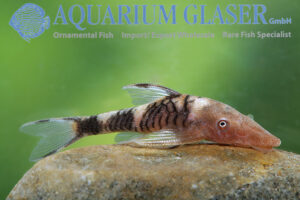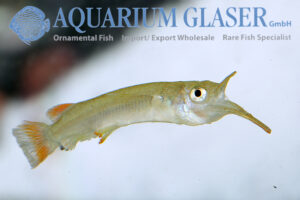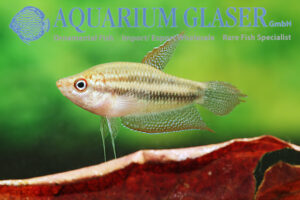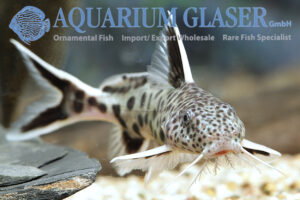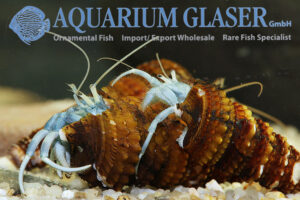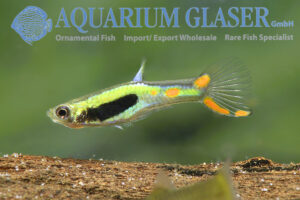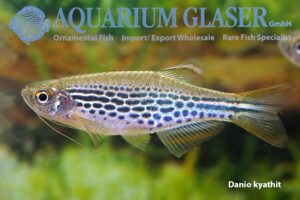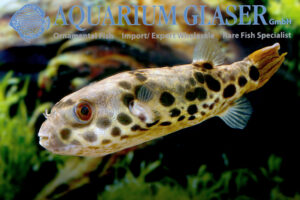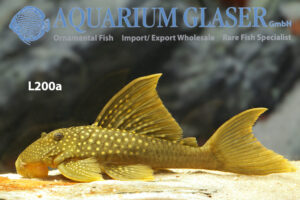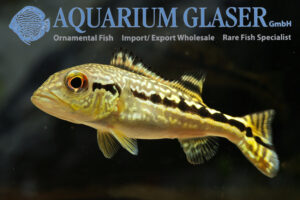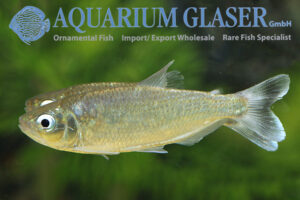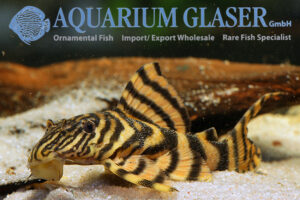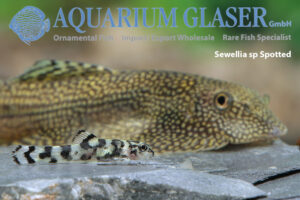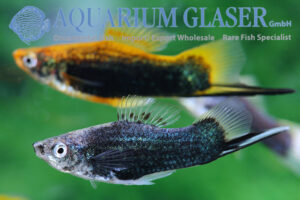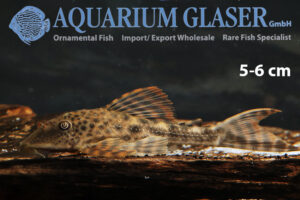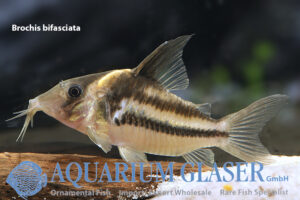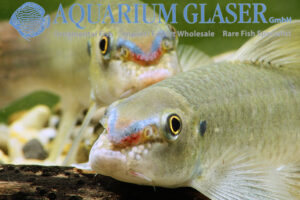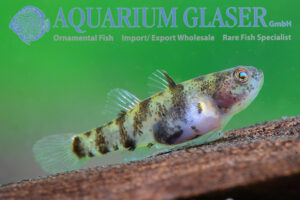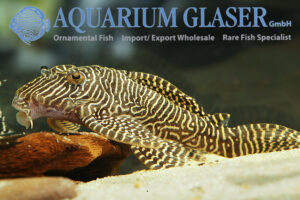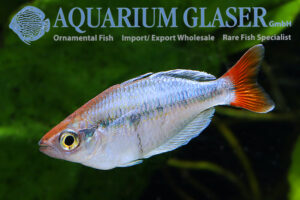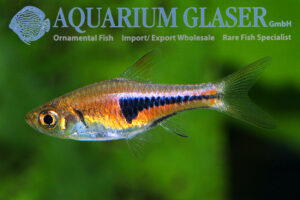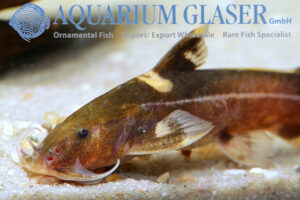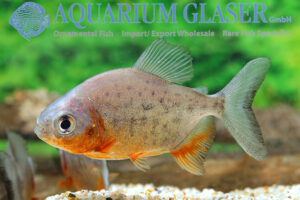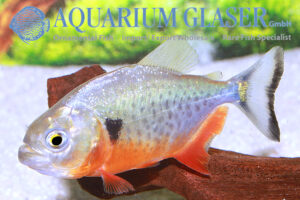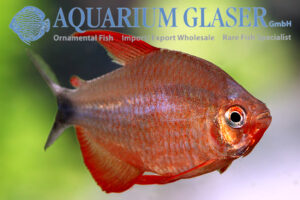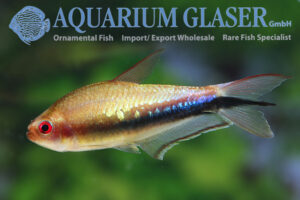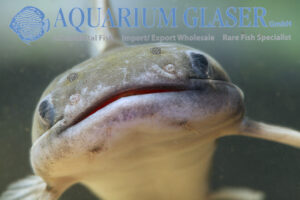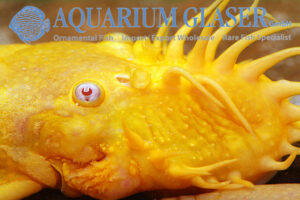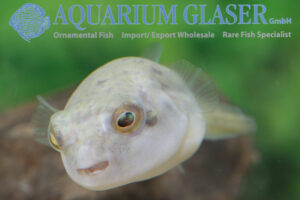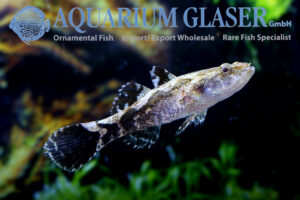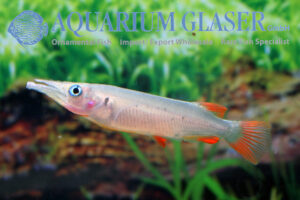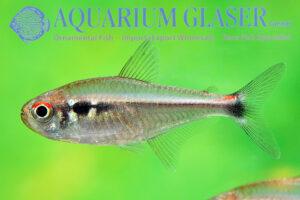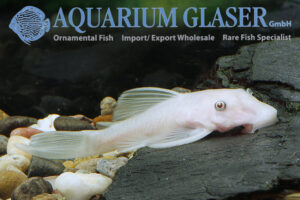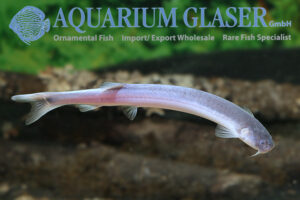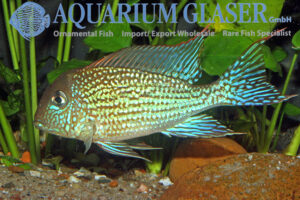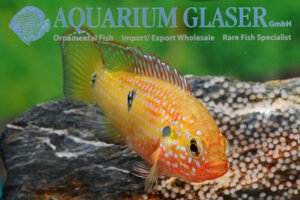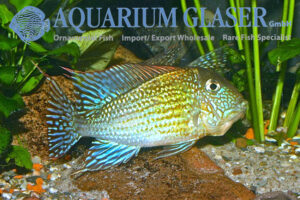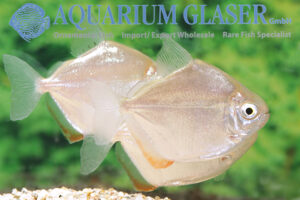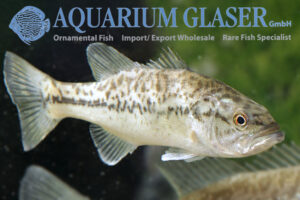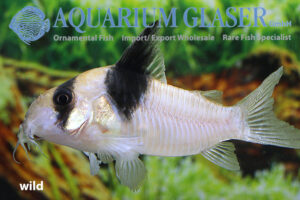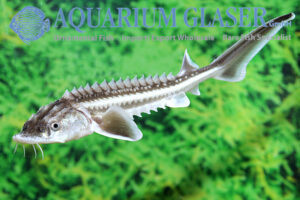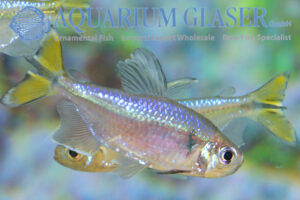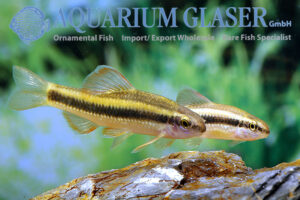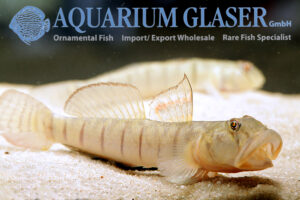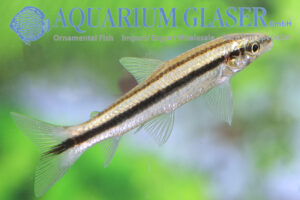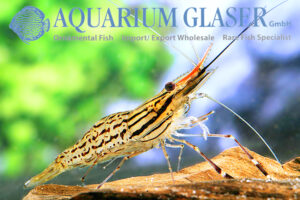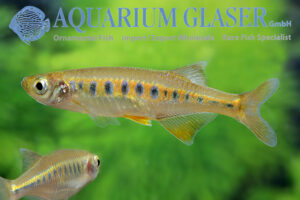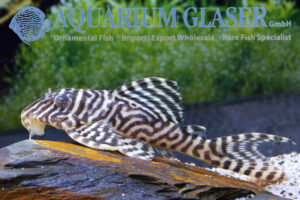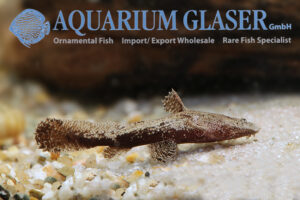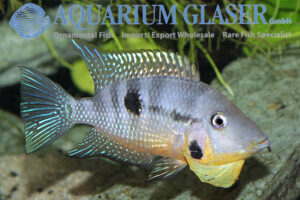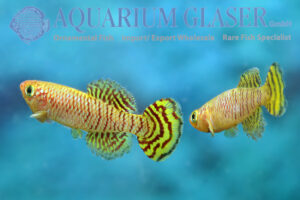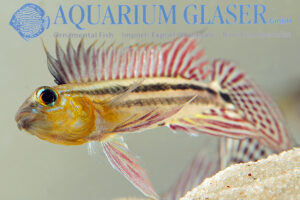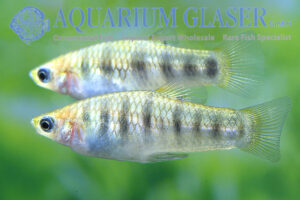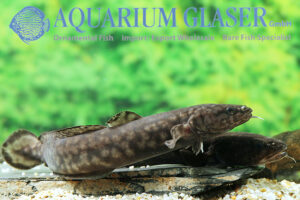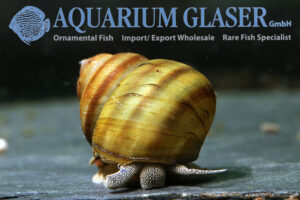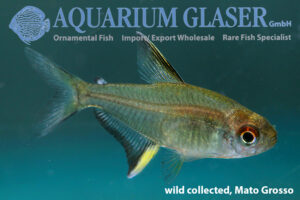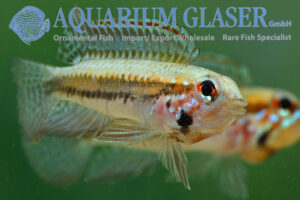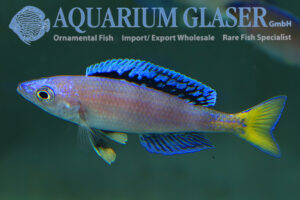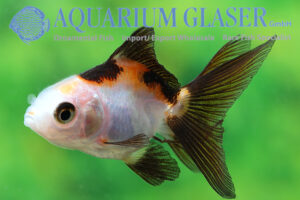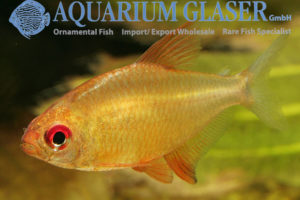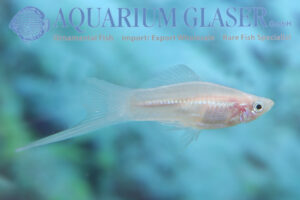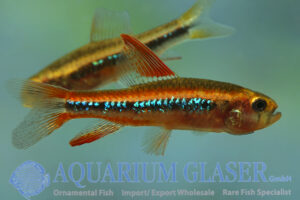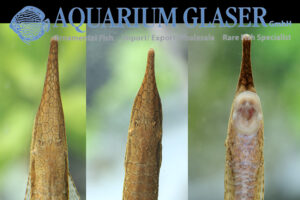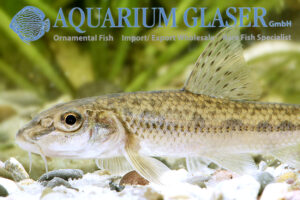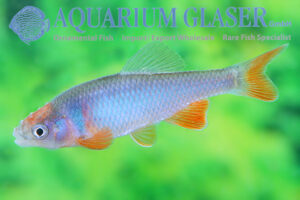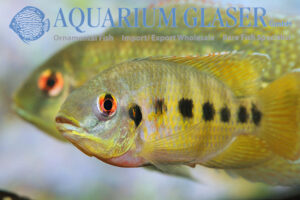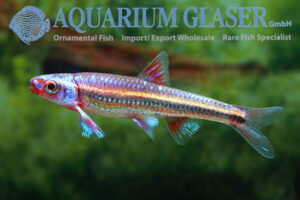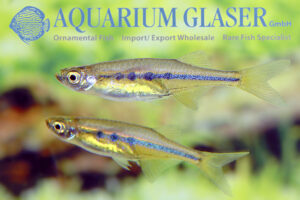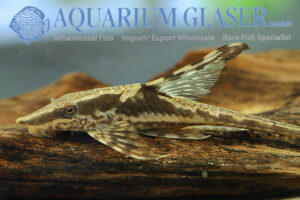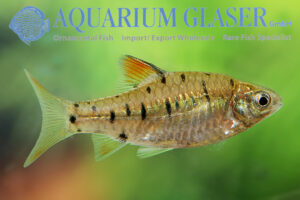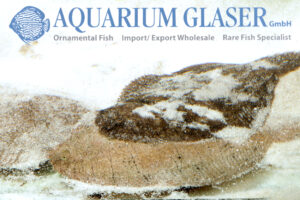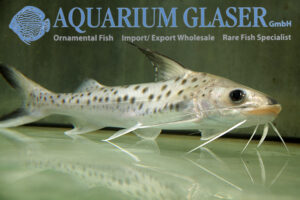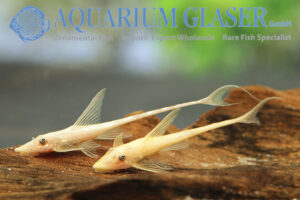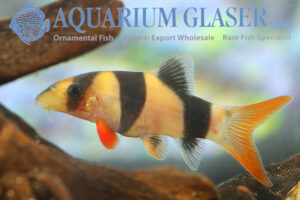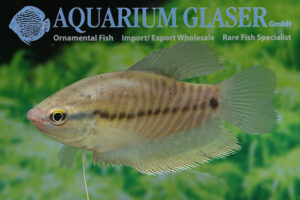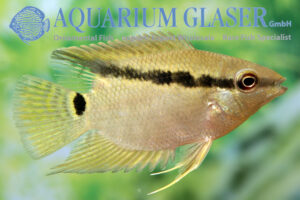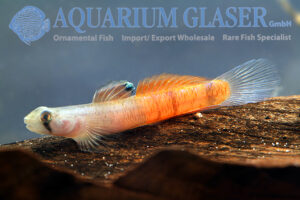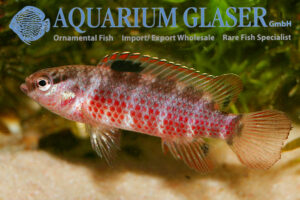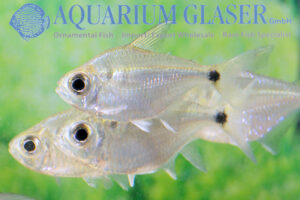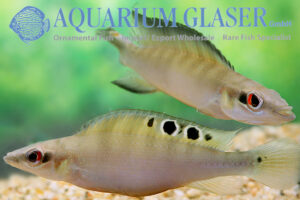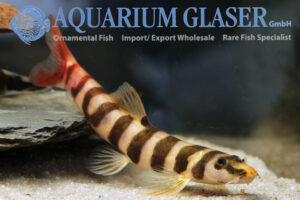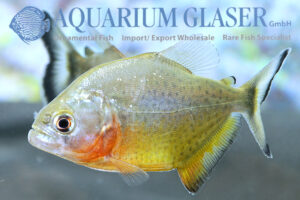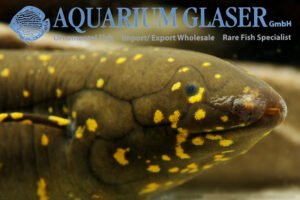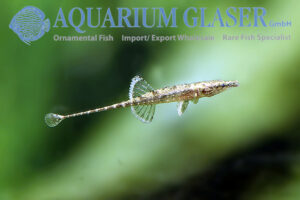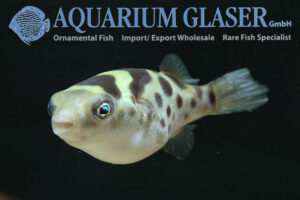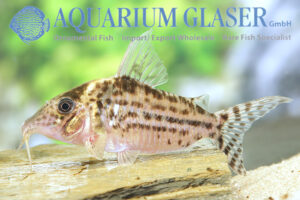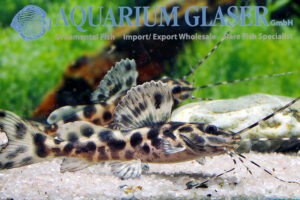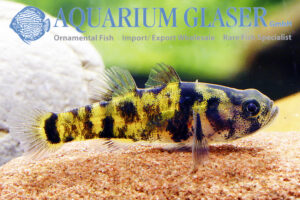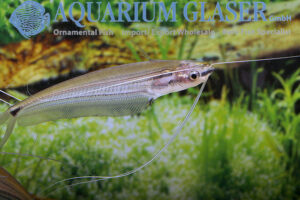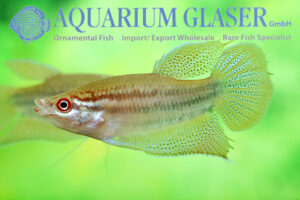Armored catfish are known to be a very species-rich and diverse group of fish. The largest species can grow to a length of one meter; Nannoptopoma are among the smallest known species, reaching only about 3-4 cm in total length. The genus Nannoptopoma is easily recognizable by its eyes, which are positioned very far to […]
Fish Archive (3096)
-
-
Nomorhamphus cf. kolonodalensis
For the first time we succeeded in importing a highly interesting, apparently small half-beak species from Sulawesi (formerly Celebes), which is most probably N. kolonodalensis. This species was scientifically described in 2000. It is named after the Kolonodale region. The Black Sulawesi Halfbeaks Nomorhamphus celebensis and N. towoetii, which were imported together with this species, […]
-
Trichopsis schalleri
Schaller’s Croaking Gourami is one of the unfortunately rarely available labyrinth fish. These pretty animals mostly come from central Thailand (they can be found comparatively far north and also in Vietnam) and grow to around 4 cm in length. This makes them slightly larger than the Dwarf Croaking Gurami (Trichopsis pumila 2.5-3 cm) and slightly […]
-
Synodontis petricola ( = S. lucipinnis)
The squeaking catfish (Synodontis) of Lake Tanganyika became world-famous when one of their species was found to have cuckoo breeding behavior. This involves the catfish sneaking their spawn to mouthbrooding cichlids. The catfish are not only hatched by the cichlids, but the brood parasites even feed on the young cichlid stepsiblings in the mother’s mouth. […]
-
Trochilocharax ornatus
We were able to import this cute dwarf tetra from Peru for the first time in April 2003. Since then, we have succeeded in importing it from time to time. The fish was initially provisionally called “Heterocharax sp. – Orangefin Tetra” or “Hummingbird Tetra”, sometimes also referred to as “Tyttocharax sp.”. A. Zarske scientifically described […]
-
Clibanarius africanus
The cute hermit crab Clibanarius africanus has become a popular invertebrate. It is a euryhaline animal, which means that it can live in both pure freshwater and pure seawater. However, the life expectancy in pure freshwater seems to be limited to a few months, which is why it is better to keep the animal in […]
-
Xiphophorus hellerii “Berlin”
The famous Berlin cross of the swordtail is the result of a gene transfer by hybridisation. Sounds complicated? The Berlin Swordtail is a breed originally produced by crossbreeding species, which was later adapted to the appearance of swordtails by displacement breeding. In red and yellow Platy (Xiphophorus maculatus) strains, black-spotted animals occasionally appear as a […]
-
Guppy Endler Lime Green
We always have a good selection of different Endler types in stock, including both natural and cultivated forms. Especially with the Endler-Guppy the boundaries blur very quickly, because certain colour characteristics can be stabilised by selection. The “Lime Green” is a selection of the “Green” (see https://www.aquariumglaser.de/en/18-toothcarps-killis-and-livebearers/new_endler_sports_en/), but still very variable. For our customers: the […]
-
Hoplarchus psittacus
Hoplarchus psittacus is one of the very rarely available large cichlids from South America, which is called “Acara paragua” – parrot cichlid – by the indigenous population because of its red breast, which is reminiscent of the colors of some parrots in the Amazon region. Hoplarchus psittacus is the only species of the genus. It […]
-
Danio kyathit and D. quagga
From time to time we have beautiful wild catches of these two Danio species from Burma in stock, which are often characterized by particularly intense red tones in the fins. D. kyathit and D. quagga replace D. rerio, the zebrafish from India, in Burma. Apart from the coloration, the three species are absolutely identical, also […]
-
Tetraodon schoutedeni
In the 1960s Tetraodon schoutedeni was one of the most common freshwater puffers in the trade. Also the breeding of the animals succeeded regularly. The fish are free spawners without brood care. But the civil war in Congo changed the situation drastically and even nowadays catchers are reluctant to go to the occurrence areas of […]
-
L200 Hemiancistrus subviridis and Baryancistrus demantoides
L-numbers were never intended as a substitute for scientific species designations, but rather to illustrate the diversity of imported loricariids and simplify communication. This is why it happened more frequently that the same zoological species was given several L-numbers, e.g. L18, L81 and L177. They look different, but belong to the same species, namely Baryancistrus […]
-
Chrosomus erythrogaster
Unfortunately, only very few small fish species from the USA are represented in the hobby. One of the species occasionally offered is the very pretty minnow species Chrosomus erythrogaster. This species is widespread in the wild and common in suitable habitats. It is usually found in small mountain streams from Minnesota and western Pennsylvania, south […]
-
Cichla sp. Royal Silk
People with large aquariums often also want large fish. It’s amazing how many people with large or even very large aquariums there are nowadays; otherwise it’s hard to explain why the Tucunaré or peacock cichlids of the genus Cichla, which used to be considered specialist fish and only develop their most beautiful coloration from around […]
-
Caridina mariae Deep Blue Tiger Yellow Eyes ( = Neocaridina sp. Tiger)
Tiger shrimps were among the first dwarf shrimp species to enter the hobby around 30 years ago. At that time, they were still simply numbered, the “Tiger” was Caridina or Neocaridina sp. V. Only specialists can clarify the genus affiliation of dwarf shrimps, there are no recognizable characteristics on live animals. In 2015, Klotz & […]
-
Brycon cf. pesu1
The genus Brycon comprises around 45 species, which are distributed across large parts of South and Central America. They hardly play a role in aquaristics, but are very important as food fish. They are medium-sized to large fish. The smallest species belong to the B. pesu complex (approx. 16 cm standard length, i.e. without caudal […]
-
Panaqolus sp. L374
There are several tiger plecos of the genus Panaqolus. First L2 was imported from the Rio Tocantins and introduced in 1988 in the very first “L-catfish article” in the Datz. In 1992, LDA1 from the Rio Negro was added, which was given the additional L number 169 in 1994. The tiger pleco presented in 2001 […]
-
Sewellia sp. Spotted (SEW01)
The genus Sewellia includes the most popular and probably most beautiful of all hillstream loaches: Sewellia lineolata (see https://www.aquariumglaser.de/en/fisharchive/sewellia-lineolata-2/). Enthusiasm for this fish continues to this day. Scientifically, considerably more species of Sewellia are known; a total of 18 species have been described to date, but the status of some species from Vietnam, which were […]
-
Xiphophorus hellerii black
The black breeding form of the swordtail Xiphophorus hellerii is also known as the Hamburg breeding form because the aquaristic tradition that is often cited states that it was first bred in Hamburg in 1912 by a breeder named W. Hoffmann. However, it is also undisputed that other black strains were created somewhat later independently […]
-
Hypostomus boulengeri
Every aquarist probably knows the genus Hypostomus by name, to which 154 species are currently assigned (including Cochliodon, which is sometimes seen as an independent genus and sometimes as a synonym of Hypostomus). Of this huge variety, however, only one species is regularly found in the trade, namely Cochliodon basilisko, also known as Red Bruno. […]
-
Brochis bifasciata ( = Corydoras bifasciatus)
Given the current (June 2025) 159 C-numbers and 216 CW-numbers, you would think that all 203 scientifically accepted species of the subfamily Corydoradinae (i.e. Aspidoras, Brochis, Corydoras, Gastrodermus, Hoplisoma, Osteogaster and Scleromystax) would be appearing more or less regularly in the hobby. But this is not the case. Two longnosed species from the Rio Tapajós […]
-
Garra panitvongi ( = sp. Red Tail)
This beautiful sucking barb was scientifically described in 2023 in honor of the meritorious naturalist Nonn Panitvong. Nonn found the animals together with other members of siamensis.org in 2006, so the location (the Kasat River in western Thailand) is well documented. For the history of the discovery of this species, please see https://www.aqualog.de/blog/garra-sp-rotschwanz-godzilla-kommt-vom-kasat-river/ The article […]
-
Brachygobius mekongensis
In the genus Brachygobius we find some of the smallest freshwater goby species. One of these dwarfs is B. mekongensis, a species that was only scientifically described in 2000. The late scientific recording of this species, which is widely distributed in the Mekong River basin in Laos, Cambodia and Thailand, is due to the fact […]
-
Hypancistrus sp. L260 Queen Arabesque
It is astonishing that this strikingly colored catfish from the Rio Tapajós in Brazil (state of Para) has not yet been scientifically recorded. Since 1998 it has carried the L-number 260 and since then has also been one of the regularly imported and bred L-catfish. There are great similarities to L411 from the Rio Jari. […]
-
Rasbora daniconius
From India we were able to import Rasbora daniconius, This minnow usually grows to 6-8 cm in length, the largest specimen ever measured supposedly measured 15 cm. The species is found in Bengal together with such well-known and popular ornamental fishes as zebra danio (Danio rerio), rosy barb (Pethia conchonius), dwarf gourami (Colisa lalius) and […]
-
Melanotaenia sp. “Kali Tawa”
This new dwarf rainbowfish, which has obviously not yet been scientifically described, was only introduced to the aquarium hobby in 2019. As is so often the case with rainbowfishes, it was found during a privately funded and conducted research trip. Its provisional name Melanotaenia sp. “Kali Tawa” refers to the place where it was found […]
-
Trigonostigma espei
Of the five species currently assigned to the genus Trigonostigma (harlequin barbs) – the well-known common harlequin barb T. heteromorpha, the most recently described T. truncatus, the dwarf T. somphongsi, T. hengeli and T. espei – the last two are often confused; unfortunately, this also happens to us from time to time if we are […]
-
Glyptothorax buchanani
The mountain catfish (Glyptothorax) are virtually unknown in aquaristics. It is a very species-rich group (almost 120 accepted plus presumably numerous undescribed species) of mostly small, current-loving catfish. The extremely limited experience of keeping these catfish shows that (as with many stream fish) they are sensitive animals that do not tolerate heavy organic pollution or […]
-
Piaractus brachypomus
Internationally, the largest serrasalmid species are called “pacu”: the red bellied pacu (Piaractus brachypomus, formerly Colossoma brachypomus or C. bidens) from the Amazon system, its twin species P. orinoquensis, which has only been differentiated from it since 2019, the yellow pacu (P. mesopotamicus) from the Parana-Paraguay system and the black pacu or cachama (Colossoma macropomum) […]
-
Pygocentrus cariba ( = P. notatus)
Pygocentrus are the most famous and aquaristically most important piranhas. In contrast to all other piranhas, Pygocentrus are always schooling fish. They are less keen on fin pieces of other fish than Serrasalmus and Pristorycon species and with their particularly sharp teeth they can bite whole pieces out of a body. However, the Pygocentrus species […]
-
Hyphessobrycon peugeotorum ( = H. peugeoti)
It’s amazing how many new, attractive tetra species have been discovered recently! Among them is Hyphessobrycon peugeotorum, which was only scientifically described in 2013 under the name H. peugeoti. It originates from the Brazilian state of Mato Grosso (middle drainage of the Rio Juruena, upper basin of the Rio Tapajós). The unusual species name does […]
-
Nematobrycon lacortei
The Rainbow Emperor Tetra (Nematobrycon lacortei) is certainly one of the most attractive tetras in South America. Its home is in western Colombia where it is caught in the catchment area of the Rio San Juan. Males and females can be easily distinguished by the color of the iris. Already in small juveniles the males […]
-
Tocantinsia piresi
We just received one of the very rare imports of a very peculiar representative of the Auchenipteridae (driftwood catfish): Tocantinsia piresi. These catfish were first discovered in 1974 in the Rio Tocantins near Porto National in the state of Goiás in Brazil. Because they did not fit into any known genus, Mees described them as […]
-
Ancistrus sp. “Gold Albino”
Albinism is a mutation that can occur in almost any animal species, including humans. The word is derived from the Latin “albus” = white. The expression of the mutation is admittedly different. In some forms of albinism, some melanin (the black cell pigment) is still produced, in other forms hardly any or none at all. […]
-
Tetraodon lineatus “bred”
The up to 40 cm long Nile pufferfish (Tetraodon lineatus) is a magnificent freshwater species from Africa. We have presented it in detail here: https://www.aquariumglaser.de/fischarchiv/tetraodon-lineatus-15-20-cm/ For some time now, we have also bred specimens of this species from Indonesia in stock. In Nigeria – the home of these fish – fewer and fewer people want […]
-
Oxyeleotris marmorata
Most gobies live in the sea. And most gobies stay small, usually less than 10 cm. So Oxyeleotris marmorata, the Marbled Sleepergoby, is an exception in more than only one respect. The species is a giant among the gobies and becomes more than 50 cm long. And usually it lives in pure freshwater; only occasionally […]
-
Nomorhamphus ebrardtii
We imported very nice specimens of the halfbeak Nomorhamphus ebrardtii. This livebearing fish lives endemic (this means: exclusively there) on the island of Sulawesi, formerly known as Celebes. Here the species occurs mainly in smaller brooks. Maximum length of N. ebrardtii is around 6-7 cm. The bright orange-red fins are very striking as well as […]
-
Ancistrus sp. “Snow White Longfin”
When asked: “May it be a little more?”, many Ancistrus enthusiasts answer: “Yes, I’d love to!”. The result is Veil Ancistrus, which are now available in pretty much all colors of the popular aquarium Ancistrus. Of course, the “Snow White Longfin” are still quite exclusive and only available from time to time. There are both […]
-
Hyphessobrycon montagi
With over 130 species, the genus Hyphessobrycon has become very confusing. New species are still being discovered. It has long been known that Hyphessobrycon is an artificial collective genus and that the species in it are not necessarily closely related to each other. For this reason, “groups” have been defined within Hyphessobrycon from time to […]
-
Ancistrus “Snow White”
White animals – preferably as pure white full albino with red eyes – exert a special attraction on many people. The white coloration gives them the impression of special purity and innocence. It is therefore no wonder that albinos sooner or later appear in the trade from almost all very frequently kept and bred animal […]
-
Pareiodon cf. microps
The parasitic catfish of the subfamily Stegophilinae within the pencil catfish (Trichomycteridae) are famous and notorious as “Candirus”. They often specialize in blood as food and swim like little vampires into the gill cavity of large catfish, where they bite into a blood vessel and pump themselves full of the red elixir of life. Apparently […]
-
Once again: Geophagus mirabilis
Due to a misunderstanding, we inadvertently posted some wrong pictures last week. Instead of the Geophagus mirabilis described in the text, they were breeding specimens of G. sp. “Jatapu”, a scientifically undescribed species that we will soon be able to offer. Here are the correct pictures of fully grown Geophagus mirabilis. Our heartfelt thanks to […]
-
Rubricatochromis guttatus “Yellow Sunshine”
The red jewel cichlids (Rubricatochromis, formerly Hemichromis) have been appearing in thermal waters in Central Europe for decades and seem to feel very much at home there. The first documented cases date back to the 1970s from the warm streams of Villach (Carinthia, Austria), but in the meantime they have appeared almost everywhere where the […]
-
Geophagus mirabilis
All Geophagus species are beautiful, but some are more beautiful than others. Since 2009, aquarists have known of a beautiful earth eater that only occurs in the Rio Aripuanã catchment in Brazil. Accordingly, the species was initially referred to as Geophagus sp. “Aripuana”. In January 2015, the beautiful species was scientifically described for the first […]
-
Metynnis “hypsauchen” ( = M. altidorsalis)
Silver dollars are the herbivorous counterparts to the carnivorous piranhas. Among them, the genus Metynnis – recognizable by its long, flat adipose fin – is the most important aquaristically, as its members still fit reasonably well into standard aquariums with a final size of 15-20 cm. Representatives of other genera can grow considerably larger. One […]
-
Micropterus salmoides
Large mouth bass (Micropterus salmoides) originally come from the eastern United States where they inhabit waters from the Canadian border to Mexico. Since the 1880s, they have been introduced to Europe (and elsewhere) as sport and food fish and are now found wild in many areas. They are among the 100 most dangerous invasive species […]
-
Hoplisoma (formerly Corydoras) sp. CW49
Two beautiful new panda catfish (Hoplisoma) arrived from Colombia in 2010. As these species have not yet been scientifically studied, they have been assigned the code numbers CW49 and CW51. At first there was some confusion as to whether they were different species or just two color forms of the same species. Both have already […]
-
Acipenser gueldenstaedtii
Sturgeons are fascinating, ancient fish that have lived on earth for around 200 million years. Unfortunately, almost all species are threatened with extinction in the wild; the main reason is – as always – habitat destruction. As sturgeons have a complex migratory behavior and most species live partly in the sea and partly in fresh […]
-
Alestopetersius caudalis
The yellow Congo tetra (Alestopetersius caudalis) is a popular and frequently offered ornamental fish. The species originates from the Congo, where it is at home in the lower reaches of the African river. Wild-caught fish are very rare in the trade. The species was first imported around 1950 and was soon bred. The animals in […]
-
Sarcocheilichthys parvus
The genus Sarcocheilichthys from China has the potential to become a new star in the ornamental fish sky. There is a complex of small (6-7 cm) species within the genus in southern China, which are characterized by a broad longitudinal band. The males of all three species develop very pretty vermilion fins at spawning time. […]
-
Awaous flavus ( = A. strigatus)
The butterfly goby (Awaous flavus, formerly known aquaristically under the synonym A. strigatus) has a large distribution area along the Atlantic coast of South America. They are found in the lower reaches of rivers in Brazil, Guyana, Suriname, Venezuela, Colombia and on islands off the coast. Adults of this species, which is a maximum of […]
-
Parodon sp. cf. pongoensis
The Parodontidae are a relatively small group of bottom-dwelling tetras. The family consists of three genera with a total of approx. 32 species. The genera are distinguished from each other by two characteristics: firstly, the number of unbranched rays in the pectoral fin: one each in Parodon and Apareiodon and two in Saccodon; and secondly, […]
-
Macrobrachium spinipes
Macrobrachium rosenbergii is the largest and therefore frequently bred large-armed shrimp in aquaculture for food purposes. We have this impressive species more or less regularly in our program for specialists and show aquariums. For the biology and pictures of this species, see https://www.aquariumglaser.de/en/31-crayfishes-shrimps-crabs-snails-mussels/macrobrachium-rosenbergii-3/ M. spinipes is closely related to M. rosenbergii and has often been […]
-
Inlecypris auropurpureus
Lake Inle in Burma has a high proportion of endemic fish species, i.e. those that are found exclusively there. One of these is Inlecypris auropurpureus, a Danio with vertical stripes on a golden band. The number and shape of the stripes are slightly different in each individual. Inlecypris is closely related to the malabar danio […]
-
L66 is now Hypancistrus seideli
The scientific processing of loricariid catfishes with L-numbers is progressing. The confusing variety of forms that some species develop is a problem that is almost impossible to solve, even for ichthyologists, i.e. professional fish experts. In a recent study, a team of scientists looked at two Hypancistrus species from the Rio Xingu, namely L174, which […]
-
Chanda nama
Until the 1950s, all aquaristically known species of glass perch were known under the genus name “Chanda”. The first major regrouping was carried out in 1955 by Fraser-Brunner, who revived the (old) genus Ambassis (with 20 species), placed the species nama in the monotypic genus Hamiltonia (i.e. only one species is assigned to it), established […]
-
Chaca chaca GERMAN BRED
Frogmouth catfish (Chaca) are rarely kept in the aquarium and even more rarely bred. There are four species: Chaca chaca from India, C. burmensis from Burma, C. bankanensis from Malaysia and parts of Indonesia and C. serica from south of Borneo. The four species look very similar and were not distinguished from each other for […]
-
Thorichthys affinis
“The unexpected often happens” says the well-known proverb. That’s what happened to us with Thorichthys affinis. Some time ago we received juveniles of – according to the breeder – Thorichthys meeki, the firemouth cichlid. The 3-4 cm long juveniles didn’t have much to offer in terms of color, but they were extremely harmonious in terms […]
-
Nothobranchius ruudwildekampi
The genus Nothobranchius is a prime example of how aquarium keeping and science complement each other wonderfully. These killifish are typical seasonal fish; the genus is restricted to East Africa and offshore islands. In the wild, Nothobranchius only live for a few weeks. They produce eggs, which survive the drying out of the rainwater pools […]
-
Apistogramma bitaeniata Blue wild
We have already reported on Apistogramma bitaeniata several times, please see hhttps://www.aquariumglaser.de/en/25-perchlike-fishes/apistogramma-bitaenata-brazil/ or https://www.aquariumglaser.de/en/fisharchive/apistogramma-bitaeniata-putumayo-4/. This species is without doubt one of the most beautiful dwarf cichlids around. We have recently received a locality variant from Brazil that differs in color from the specimens we normally obtain from there. In the light of the torch, we […]
-
Limia islai
Lago Miragoane in Haiti is one of the largest natural freshwater lakes in the Caribbean, with a length of 12 km and an area of about 25 km2. In terms of its fish fauna, it is aquaristically exciting. Similar to the cichlids in the great African lakes, the livebearing toothcarps of the genus Limia have […]
-
Lota lota
Do you know him? When a biologist comes to the fish facility, the fish keeper says: there are 50 of them and they’re all called Lothar! All jokes aside: Lota lota, the burbot or eelpout, is hardly ever seen alive as a juvenile fish, even by enthusiastic cold-water aquarists. It is one of the very […]
-
Megalamphodus erythrostigmus = Hyphessobrycon erythrostigma
The regrouping of large fish families continues. After the barbs, armored catfish and cichlids, it’s now the turn of the characins. A major revision was published in September 2024, prompting us to retrain once again. Not all tetra species have been included yet, so it will certainly take a few years before the new name […]
-
Viviparus viviparus
Among the freshwater snails native to Central Europe, three species play a special role due to their considerable size (4 cm and larger): the ramshorn snail, the great pond snail and the river snail. At least in the case of the latter – the river snail – the specific article “the” river snail is actually […]
-
Hyphessobrycon pulchripinnis
The lemon tetra, Hyphessobrycon pulchripinnis, is one of the most popular aquarium fish of all and can be found in the standard range of pet shops all over the world. As with so many everyday species, little thought is given to them, but the lemon tetra holds many secrets! Its native habitat was unknown until […]
-
Apistogramma psammophila
The two-banded dwarf cichlid, Apistogramma diplotaenia, is one of the dream fish of many Apistogramma lovers. The species originates from the Rio Negro drainage in Brazil. Unfortunately, this fish is also one of the most demanding species of the genus and even minor carelessness – e.g. a missed water change and the resulting increase in […]
-
Cyprichromis leptosoma “Mpulungu”
Cyprichromis and Paracyprichromis are very special mouthbrooding cichlids from Lake Tanganyika. The animals sometimes live in huge shoals and feed on small animals that they pick out of the free water column. To attract the attention of the females, the males can be very brightly colored. They do not occupy actual territories. The females, on […]
-
Carassius auratus – Goldfish Oranda Tricolor
The breeding of certain goldfish is one of the most demanding of all breeding activities – if it is done consciously. This is because characteristics such as coloration, finning, eye and skin changes in goldfish are usually not controlled by a single gene, but by several genes. This also affects the expression, i.e. larger or […]
-
Hyphessonbrycon cf. pulchripinnis “Bolivia Orange”
The lemon tetra, Hyphessobrycon pulchripinnis, is one of the most popular aquarium fish of all and can be found in the standard range of pet shops. As with so many everyday species, little thought is given to them, but the lemon tetra holds many secrets! The ancestors of the animals that we can occasionally offer […]
-
Xiphophorus hellerii, cave swordtail
Central America is famous for its numerous karst caves. A particularly interesting fauna has often developed in them. Perhaps the best-known cave fish in Mexico is the blind cave tetra (Astyanax jordani or Anoptichthys jordani, see https://www.aquariumglaser.de/en/fisharchive/blind-cave-tetras/). As with many cavefish, its eyes are severely atrophied. However, there are four underground lakes in the home […]
-
Poecilocharax weitzmani
Of course, this fish is anything but a novelty and has been imported in relatively large numbers for many years. But isn’t it beautiful? This small animal is an ideal companion for the cardinal tetra (Paracheirodon axelrodi), with which it also occurs in the wild. Poecilocharax weitzmani grows to 3-4 cm and is relatively widespread […]
-
Farlowella hahni
The needle catfish (Farlowella) are whimsical representatives of the loricariid catfishes (Loricariidae), reminiscent of sticks. They graze on fine growth with their typical sucking mouth. They are usually common animals in the wild, which is why they attracted the attention of scientists early on. The first species was described in 1853 (F. acus), the last […]
-
Gobio gobio, gudgeon
The gudgeon, Gobio gobio, is one of the smallest native fish. It usually grows to 8-12 cm, rarely over 15 cm long. The record is said to be 21 cm, but such giants are as rare as people over 2.20 m long. Because of its small size and pretty colouring (compared to the mostly silvery […]
-
Cyprinella lutrensis
There are numerous species (approx. 320) of minnow relatives in North America, but only very few species have become aquarium fish to date. In contrast to our native minnow, the Red Shiner (Cyprinella (formerly: Notropis) lutrensis) is a fairly undemanding fish and does not require such low temperatures. Although the species can be kept in […]
-
Pelmatolapia mariae
In contrast to the larger Central American cichlids of the Cichlasoma relationship, the medium-sized African cichlids of the Tilapia relationship, which are ecologically quite similar to them, have never managed to become widespread in aquariums. The reasons for this lie in the geographical proximity of Africa to Europe. When aquarium keeping became widespread around 1900 […]
-
Hydrophlox chrosomus ( = Notropis chrosomus)
The “rainbow shiner” (Hydrophlox chrosomus, formerly Notropis c.) was a sensational fish in the early 2000s. Strangely enough, only very few of the almost 325 species of North and Central American minnows and shiners have ever become established as aquarium fish. The fact that these animals are highly complex from a systematic-taxonomic point of view […]
-
Neochela dadiburjori ( = Laubuka dadiburjori, = Chela dadiburjori)
This nano-fish jewel comes from the south of India (Kerala); the delightful dwarfs grow to a maximum length of 3 cm. They are absolutely peaceful schooling fish that prefer to spawn on the upper side of broad leaves, especially on Ludwigia species. However, they also show an amazing ability to adapt. About 50 years ago, […]
-
Sturisomatichthys aureus
As is well known, the royal farlowellas (Sturisoma and Sturisomatichthys) were reclassified in 2019, resulting in some regrouping. Several species previously classified as Sturisoma now belong to the genus Sturisomatichthys. According to Londoño-Burbano & Reis, 2019, externally recognizable differences between the two genera are the irregular, numerous central ventral plates that are not arranged in […]
-
Barbodes semifasciolatus ( = Barbus s.)
The Chinese barb (Barbodes semifasciolatus) was one of the first “exotic” ornamental fish to be kept in aquaria. Under the completely misleading name “Japanese bitterling”, they were introduced and bred as early as 1897 in the then still young aquarium hobby. In the first known article on the species (May 1897 in the “Blättern für […]
-
Hypoclinemus mentalis
Flounders do not belong to the classic aquarium fish; most species live in the sea and become quite large. In the New World, there is the family Achiridae with 35 species in 9 genera, all of which are either euryhalin, i.e. can change freely between fresh and sea water, or live in pure fresh water. […]
-
Platynematichthys notatus
Platynematichthys notatus is one of the extremely rare species on the ornamental fish market. There is only one species of the genus, but it is widely distributed in the Amazon and Orinoco river systems (Bolivia, Brazil, Ecuador, Colombia and Venezuela). This fish is usually only caught in the strong current, oxygen-rich areas of the main […]
-
Sturisomatichthys ALBINO
As is well known, the royal farlowellas (Sturisoma and Sturisomatichthys) were reclassified in 2019, resulting in a number of regroupings. Several species previously classified as Sturisoma now belong to the genus Sturisomatichthys. According to Londoño-Burbano & Reis, 2019, externally recognizable differences between the two genera are the irregular, numerous central ventral plates that are not […]
-
Chromobotia macracanthus ( = Botia macracantha) BRED
There are only two species in the global ornamental fish trade that have been traded in large numbers for decades collected from the wild: the Cardinal tetra (Paracheirodon axelrodi) and the Clown loach (Chromobotia macracanthus). Due to the great economic importance of these animals, the populations are monitored very closely and there are strict laws […]
-
Trichogaster pectoralis
The snakeskin gourami (Trichogaster pectoralis) is the largest and most peaceful species of gourami. The animals can become 20-25 cm long and are therefore in their homeland Southeast Asia also estimated food fish. However, we prefer to enjoy their calm nature and beautiful coloration. For years there has been a dispute about the correct genus […]
-
Mesonauta egregius
The flag cichlids (Mesonauta) are beautiful and peaceful, medium-sized cichlids that reach a length of 12-15 cm. In the wild they usually live together with angelfish (Pterophyllum), which they also resemble in terms of behavior and general requirements in the aquarium. As with the angelfish, the sexes are indistinguishable in younger animals. In older specimens, […]
-
Sicyopus zosterophorus
The gobies (Gobiidae) are probably one of the most species-rich families of fish with over 2,000 species (currently accepted: around 1,500 species). Many gobies live in the sea, but gobies are often the most common fish in the freshwater of oceanic islands. In these cases, they are usually species that live as adult fish in […]
-
Badis singenensis ( = sp. Buxar)
Badis singenensis ( = sp. Buxar) A beautiful, small chameleon fish (Badis) originates from the north of India, which has a reduced swim bladder as a special feature within the genus. As a result, it is very bottom-bound and moves around somewhat hopping. The maximum length of this species is approx. 4-5 cm including the […]
-
Tetragonopterus denticulatus
The genus Tetragonopterus used to be the catch-all for all smaller tetra species, which are now found in the genera Hemigrammus, Hyphessobrycon or Moenkhausia, for example. The English term “tetra” for all tetras, an abbreviation of Tetragonopterus, has survived. Nowadays there are only 14 species of Tetragonopterus, of which only T. argenteus can be considered […]
-
Wallaciia regani (formerly: Crenicichla regani) Tapajós
Cichlids are referred to as dwarf cichlids if their total length – including the caudal fin – does not exceed 10 cm. As many cichlids grow considerably larger and then also have corresponding space requirements in terms of housing, dwarf cichlids are particularly popular in the aquarium hobby. All pike cichlids of the genus Wallaciia […]
-
Oxyropsis acutirostris
Unfortunately, the “Giant Otos” of the genus Oxyropsis are rarely offered for sale. Three species are currently scientifically accepted, O. carinata and O. wrightiana, which inhabit the upper and middle Amazon basin, and O. acutirostris from the upper Orinoco and Rio Negro basin. Oxyropsis can be distinguished from the similar species of the genus Hypoptopoma […]
-
Kapuasia falaris
A new loach genus was only established in 2024, namely Kapuasia. The only species assigned to Kapuasia was K. maculiceps from the great Kapuas River on Borneo. Originally, K. maculiceps was assigned to the large collective genus Nemacheilus. As far as we know, K. maculiceps has not yet appeared aquaristically. Shortly after the genus Kapuasia […]
-
Serrasalmus spilopleura
The correct naming of piranha species is one of the most difficult chapters in fish systematics. Even the scientists specializing in this group of fish are by no means in agreement. And so we often have little choice but to identify a newly imported piranha according to the few external characteristics that are generally recognized, […]
-
Lepidosiren paradoxus 15-18 cm
We have already reported twice on the South American lungfish (Lepidosiren paradoxus), on juveniles here: https://www.aquariumglaser.de/en/02-living-fossils/lepidosiren-paradoxus-4/ and on the adult here: https://www.aquariumglaser.de/en/29-lungfishes/lepidosiren_paradoxus_en/; in both posts you will find further information. This species, which is widespread throughout South America, is a real rarity in the trade. We have just received some medium-sized specimens (8-10 cm and […]
-
Indostomus crocodilus
According to current knowledge, the genus Indostomus comprises three species: I. paradoxus from Burma (see: https://www.aquariumglaser.de/en/20-sticklebacks/indostomus-paradoxus-4/) with largely colorless fins, I. crocodilus from southern Thailand and I. spinosus from the Mekong catchment in Thailand, Laos and Cambodia. The latter two species have distinct bands in the fins, especially in the dorsal fin. While I. crocodilus […]
-
Dichotomyctere fluviatilis (formerly: Tetraodon fluviatilis)
The Green Puffers have been recently splitted from the catch-all genus Tetraodon and placed in a genus on their own, namely Dichotomyctere. Usually three diffenent species can be found in the trade: the Palembang or Figure-8-Puffer (D. ocellatus, formerly known as Tetraodon biocellatus), the Spotted Green Puffer (D. nigroviridis), and the Real Green Puffer (D. […]
-
Brochis sp. C156 Rio Purus
The armored catfish of the Rio Purus in Brazil have an enormous variety of forms, which is really hard to see through. In addition to the already variable coloration, there are also differences in the color pattern at different ages. Almost every attempt at identification leaves doubts, at least for individual animals. It is therefore […]
-
Leiarius marmoratus ( = L. longibarbis?)
There are two species of catfish in South America that look confusingly similar: Leiarius marmoratus, which the Indians call “Achara” and Leiarius (formerly: Perrunichthys) perruno. Both species grow to around 60 cm in length and have the same leopard pattern and long, ringed barbels. However, there is an easily recognizable difference: Leiarius marmoratus has 10-11 […]
-
Brachygobius sp. Ocelot
Again we could import this new species of dwarf bumble-bee goby. This tiny fish becomes only 2 cm long. It cannot be applied to any described species so far. The fish have been collected in Indonesia. In Brachygobius, one very important feature for determination is the question wether the predorsal region is scaled or naked. […]
-
Ompok pinnatus
Occasionally we receive a very unusual glass catfish from Thailand, whose incredibly long barbels immediately catch the eye. This is the species Ompok pinnatus, which was only described in 2003. These fish have little in common with the Ompok we usually import (see https://www.aquariumglaser.de/en/10-catfishes/10e-catfishes-from-asia/ompok_cf_fumidus_en/ and https://www.aquariumglaser.de/en/10-catfishes/10e-catfishes-from-asia/ompok_bimaculatus_and_o_pabda_en/), they look more like typical glass catfish (Kryptopterus), which […]
-
Trichopsis vittata
The Croaking Gourami (Trichopsis vittata) is perhaps the most common small fish in South East Asia. It grows to 4 – 6.5 cm long. It can be found almost everywhere, except in strongly flowing waters and in the mountains. Freshly caught, the Croaking Gourami is usually very attractively coloured and shimmers in different shades of […]
- 1
- 2
- 3
- …
- 31
- Next Page »





